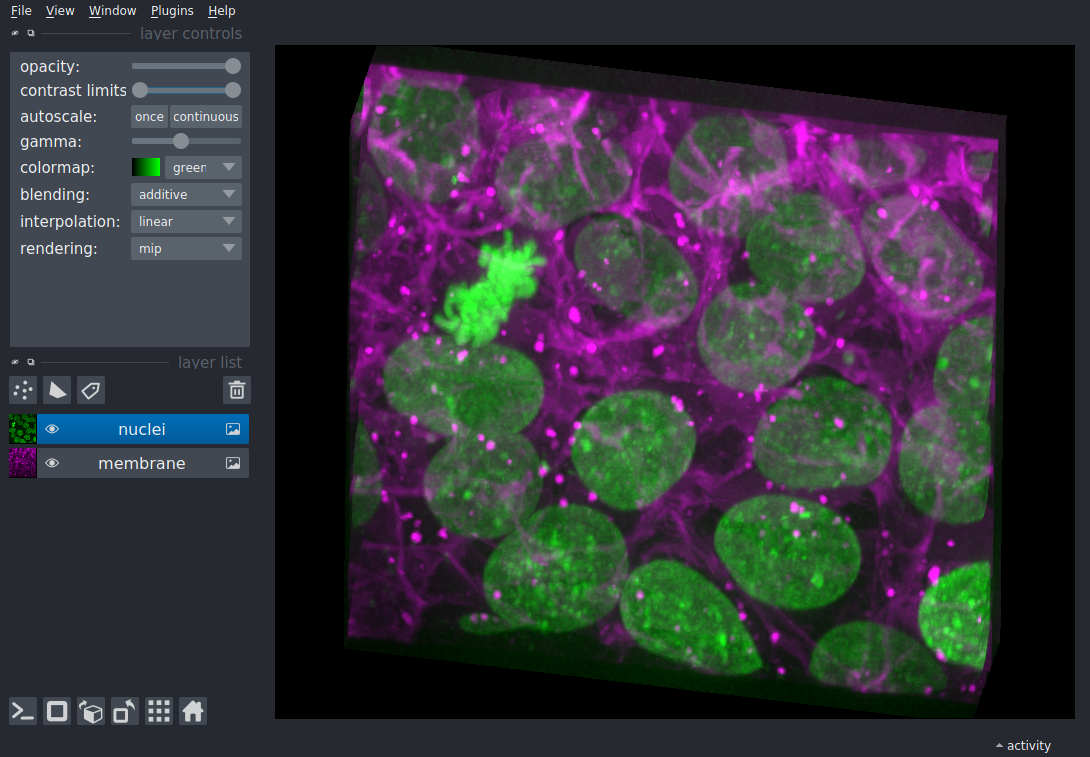napari is a fast, interactive, multi-dimensional image viewer for Python. It's designed for browsing, annotating, and analyzing large multi-dimensional images. It's built on top of Qt (for the GUI), vispy (for performant GPU-based rendering), and the scientific Python stack (numpy, scipy).
We're developing napari in the open! But the project is in an alpha stage, and there will still likely be breaking changes with each release. You can follow progress on this repository, test out new versions as we release them, and contribute ideas and code.
We're working on tutorials, but you can also quickly get started by looking below.
It is recommended to install napari into a virtual environment, like this:
conda create -y -n napari-env -c conda-forge python=3.9 pip
conda activate napari-env
python -m pip install "napari[all]"If you prefer conda over pip, you can replace the last line with: conda install -c conda-forge napari
See here for the full installation guide, including how to install napari as a bundled app.
(The examples below require the scikit-image package to run. We just use data samples from this package for demonstration purposes. If you change the examples to use your own dataset, you may not need to install this package.)
From inside an IPython shell, you can open up an interactive viewer by calling
from skimage import data
import napari
viewer = napari.view_image(data.cells3d(), channel_axis=1, ndisplay=3)To use napari from inside a script, use napari.run():
from skimage import data
import napari
viewer = napari.view_image(data.cells3d(), channel_axis=1, ndisplay=3)
napari.run() # start the "event loop" and show the viewerCheck out the scripts in our examples folder to see some of the functionality we're developing!
napari supports six main different layer types, Image, Labels, Points, Vectors, Shapes, and Surface, each corresponding to a different data type, visualization, and interactivity. You can add multiple layers of different types into the viewer and then start working with them, adjusting their properties.
All our layer types support n-dimensional data and the viewer provides the ability to quickly browse and visualize either 2D or 3D slices of the data.
napari also supports bidirectional communication between the viewer and the Python kernel, which is especially useful when launching from jupyter notebooks or when using our built-in console. Using the console allows you to interactively load and save data from the viewer and control all the features of the viewer programmatically.
You can extend napari using custom shortcuts, key bindings, and mouse functions.
For more details on how to use napari checkout our tutorials. These are still a work in progress, but we'll be updating them regularly.
For more information about our plans for napari you can read our mission and values statement, which includes more details on our vision for supporting a plugin ecosystem around napari.
You can see details of the project roadmap here.
Contributions are encouraged! Please read our contributing guide to get started. Given that we're in an early stage, you may want to reach out on our Github Issues before jumping in.
napari has a Code of Conduct that should be honored by everyone who participates in the napari community.
You can learn more about how the napari project is organized and managed from our governance model, which includes information about, and ways to contact, the @napari/steering-council and @napari/core-devs.
If you find napari useful please cite this repository using its DOI as follows:
napari contributors (2019). napari: a multi-dimensional image viewer for python. doi:10.5281/zenodo.3555620
Note this DOI will resolve to all versions of napari. To cite a specific version please find the DOI of that version on our zenodo page. The DOI of the latest version is in the badge at the top of this page.
We're a community partner on the image.sc forum and all help and support requests should be posted on the forum with the tag napari. We look forward to interacting with you there.
Bug reports should be made on our github issues using the bug report template. If you think something isn't working, don't hesitate to reach out - it is probably us and not you!







